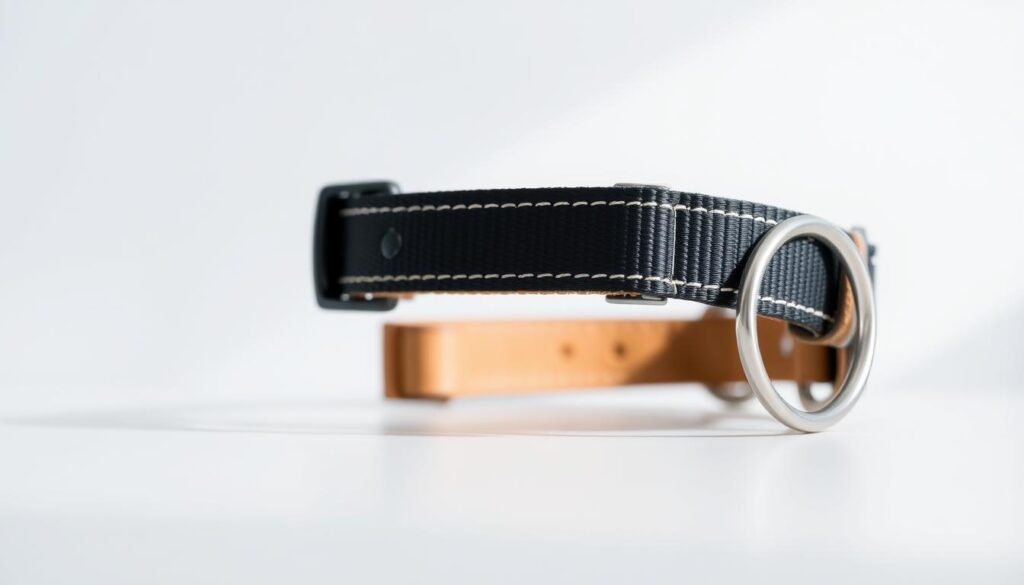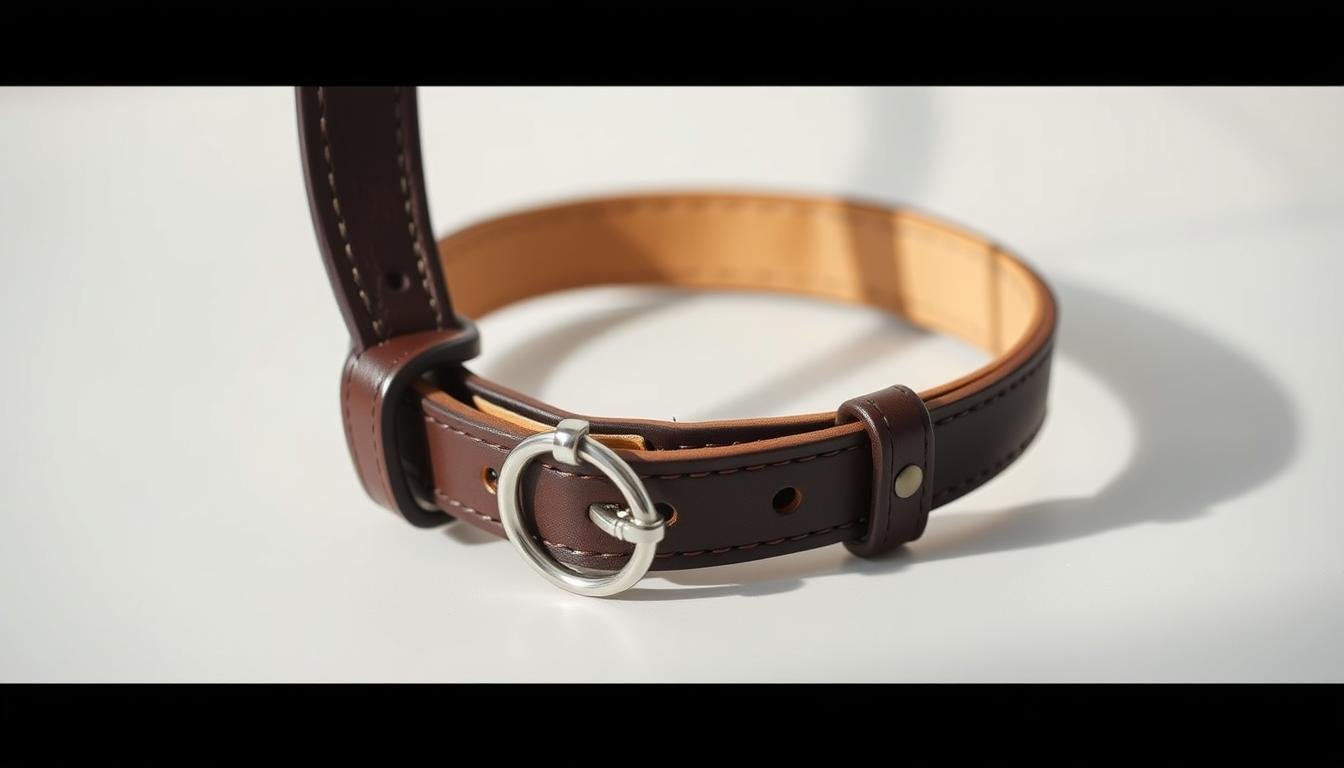Training Collars for Dogs: How to Choose the Right One for Your Pet
As a dog owner, you know how important effective training is. It strengthens your bond with your pet. A key tool in this is the dog training collar. With many types like electronic, martingale, and choke collars, picking the right one can be tough.
Choosing the best training collars for dogs depends on your dog’s size, breed, and training needs. It’s vital to know the different collars and their uses. This ensures your pet’s safety and comfort while training.
This article will help you understand the options. It aims to guide you in picking the perfect dog training collar for your pet.
Table of Contents
Understanding Dog Training Collars and Their Purpose
Dog training collars have changed a lot over time. They now offer many options for dog owners. These collars help in training, allowing dogs and owners to communicate and correct behavior.
What Are Training Collars?
Training collars are worn by dogs to help with training. They come in many types, like electronic dog training collars and traditional ones like choke chains or prong collars. Their main job is to give a correction to the dog for bad behavior.
How Training Collars Work
Training collars work differently based on their type. Electronic dog training collars, for example, use remote controls. They send a vibration, tone, or static shock to the dog. This helps the dog learn not to do the bad behavior again.
The Evolution of Dog Training Methods
Dog training methods have changed, moving towards positive reinforcement. Today’s training collars support this, offering humane and effective ways to train. Below is a table showing how dog training collars have evolved.
| Type of Collar | Description | Training Method |
|---|---|---|
| Choke Chains | Constricts when pulled | Negative Reinforcement |
| Prong Collars | Metal prongs that dig into the neck | Negative Reinforcement |
| Electronic Collars | Delivers a stimulus (vibration, tone, or shock) | Both Positive and Negative Reinforcement |
The table shows how dog training collars have moved towards more humane methods. It’s key to know the different types and their uses to pick the best one for your dog.
Types of Training Collars for Dogs
It’s important to know about different training collars for dogs. They help in training and strengthen the bond between you and your pet. Each collar is made for specific needs, so picking the right one is key to success.
Electronic/Remote Training Collars
Electronic or remote training collars are great for many reasons. They let you correct or reward your dog from a distance. This makes them perfect for off-leash training and fixing behavior problems.
Stimulation Levels and Features
These collars have adjustable stimulation levels. This means you can adjust the training to fit your dog’s needs. Some also have beep or vibration modes for different training situations.
Range and Battery Life
Look at the range and battery life when picking an electronic collar. A good range is key for off-leash training. Also, a long battery life means less hassle.
Martingale Collars
Martingale collars are safer than choke chains. They tighten when your dog pulls, stopping pulling without harm. They’re great for dogs that slip out of collars.
Prong/Pinch Collars
Prong or pinch collars correct pulling by applying pressure. They work well but are debated due to safety concerns. They must be used carefully to avoid injury.
Choke Chains
Choke chains are old-school training tools. They constrict when your dog pulls. But, they’re not recommended because of injury risks if used wrong.
Bark Control Collars
Bark control collars stop excessive barking. They use sounds or mild static to correct barking. They’re designed to help with persistent barking.
Vibration and Tone Collars
Vibration and tone collars are gentler than static collars. They use vibrations or tones to distract your dog from barking. They’re a humane choice for training.
Benefits of Using Training Collars
Training collars for dogs have many benefits. They can greatly improve your pet’s behavior and your bond with them. Knowing these advantages helps you decide if training collars are right for your dog.
Improved Communication with Your Dog
Dog training devices like collars improve how you talk to your dog. They help send clear commands and correct bad behavior. This ensures your dog knows what you expect from them.
Faster Training Results
Remote dog training collars help you train faster. They give instant feedback and correction, which is key for good training. Using these collars can speed up your dog’s learning and improve their behavior quickly.
Addressing Specific Behavioral Issues
Training collars are great for solving many behavioral problems. Whether it’s barking, pulling on the leash, or more complex issues. By knowing the problem, you can pick the right training collars for dogs to fix it.
Long-term Behavior Modification
Training collars also help with long-term behavior changes. By using them regularly in a complete training plan, you can teach your dog good habits. This reduces bad behaviors over time.
| Benefit | Description |
|---|---|
| Improved Communication | Enhances understanding between you and your dog through clear commands and corrections. |
| Faster Training Results | Accelerates the training process with immediate feedback and correction. |
| Addressing Behavioral Issues | Helps in tackling various behavioral problems effectively. |
| Long-term Behavior Modification | Contributes to sustained good behavior and reduced undesirable actions. |
Potential Concerns and Controversies
Dog training collars can be helpful, but they also spark debate. It’s important to think about how they might affect your dog’s happiness and health.
Physical and Psychological Impact
Some collars, like shock collars, worry many people. They might hurt your dog physically or make them feel stressed. Knowing these risks is key before you decide to use a collar.
Misuse and Overreliance
Another worry is using collars too much or wrong. Relying only on them can mess up training and cause more issues. It’s better to mix positive training with collar use.
Alternative Training Philosophies
More people are choosing positive training methods. These methods reward good behavior instead of punishing bad ones. This way, dogs and their owners can have a better relationship.
Research on Effectiveness and Welfare
Studies on training collars show mixed results. Some say they work well when used right, while others say we need to be careful and do more research.
To use training collars wisely, you need to know their limits and downsides. This way, you can choose what’s best for your dog’s well-being.
- Consider the potential physical and psychological impact of training collars.
- Be aware of the risks of misuse and overreliance.
- Explore alternative training philosophies that emphasize positive reinforcement.
- Stay informed about the latest research on training collar effectiveness and welfare.
How to Choose the Right Training Collar for Your Dog
Choosing the right dog training collar is important. It must match your dog’s needs and your training goals. This ensures the collar works well for your dog.
Considering Your Dog’s Size and Breed
The size and breed of your dog matter a lot. Big dogs need strong collars, while small dogs need gentle ones. This is to keep them comfortable and safe.
Identifying Your Training Goals
Knowing what you want to achieve is key. Do you want to fix bad behavior, improve obedience, or get your dog to come back faster? Your goals help pick the right training collar for dogs.
Assessing Your Dog’s Temperament
Your dog’s personality is also important. Some dogs do well with vibration or tone collars. Others might need something more traditional.
Consulting with Professional Trainers
Talking to professional dog trainers is a good idea. They can help you choose the best dog training devices. This ensures you make a smart choice for your dog.
Proper Fitting and Adjustment of Training Collars for Dogs
To get the best results from dog training, it’s key to fit the collar right. A dog training collar or electronic dog training collar that fits well is important. It makes training more effective and keeps your dog comfortable.
Measuring Your Dog for the Correct Size
To measure your dog’s neck, use a flexible tape. Wrap it around the neck to find the circumference. Remember this measurement to compare with the size chart from the manufacturer.
| Dog Breed | Neck Circumference (inches) | Recommended Collar Size |
|---|---|---|
| Small Breeds (e.g., Chihuahua) | 8-12 | Small |
| Medium Breeds (e.g., Cocker Spaniel) | 12-16 | Medium |
| Large Breeds (e.g., German Shepherd) | 16-20 | Large |
Proper Placement on the Neck
The collar should sit high on the dog’s neck, just below the ears. It should not be too tight or too loose. You should be able to fit two fingers between the collar and your dog’s neck.

Signs of Poor Fit and Discomfort
Look out for signs of discomfort or a poor fit, like excessive scratching, redness, or reluctance to wear. Adjust the collar as needed to avoid these problems.
Effective Training Techniques with Collars
Training dogs with collars works best with clear commands, consistent timing, and positive feedback. To get the most out of training collars for dogs, learn how to use them well in your training plan.
Establishing Clear Commands
Clear and simple commands are the base of good training. Your dog must know what you mean. A remote dog training collar helps by giving quick feedback to your commands.
Timing and Consistency
When using dog training devices, timing is everything. The correction should happen right when the bad behavior does. Being consistent is also vital; everyone should use the same commands and methods to avoid confusing your dog.
Positive Reinforcement Integration
Training collars are great for correcting bad behavior, but don’t forget to reward good actions. Use treats, praise, and affection when your dog does something right. This encourages good behavior and strengthens your relationship.
Gradual Training Progression
Slowly making training harder helps keep your dog challenged and reinforces what they’ve learned. Begin with easy commands and add more complex ones as your dog gets better. This way, your dog will stay focused on commands, even when things get tough.
Using these methods in your training with training collars for dogs will lead to better and longer-lasting results.
Safety Guidelines for Using Dog Training Collars
It’s important to follow safety guidelines when using dog training collars. These tools are meant to help train dogs, but misuse can harm them. It’s key to use them safely and effectively for your dog’s well-being.
Time Limitations
Limiting the time your dog wears a training collar is crucial. Long-term use can cause discomfort and harm. Make sure to remove the collar during breaks to keep your dog comfortable.
Regular Inspection of Equipment
Regularly check your dog training collar for damage. Look for frayed cords, damaged prongs, or a broken remote. A damaged collar can be ineffective or even harmful.
Monitoring Your Dog’s Response
Watch how your dog reacts to the collar. If they show signs of distress, like excessive barking or panting, change your training method. Adjust the collar’s settings or get professional help if needed.
When to Remove the Collar
Knowing when to take off the collar is as important as knowing how to use it. Remove it during rest periods or when your dog is in a safe area. This prevents accidental use and helps avoid negative associations with the collar.
Common Mistakes to Avoid When Using Training Collars
Using dog training collars can be effective, but it’s important to avoid common mistakes. These mistakes can slow down your training progress. The right use of training collars is key to success.
Relying Solely on the Collar
Many dog owners make the mistake of only using the training collar. Training collars should be part of a bigger training plan. This plan should include positive reinforcement and clear commands.
Incorrect Intensity Settings
Choosing the wrong intensity on your dog training collar can be a problem. Always start with the lowest setting and increase it slowly. Watch how your dog reacts to each change.

Inconsistent Training Approach
Consistency is crucial in dog training. An inconsistent approach can confuse your dog. This can make the training collar less effective.
Neglecting Positive Reinforcement
Not using positive reinforcement with your training collar is a big mistake. Positive reinforcement encourages good behavior. It also strengthens your bond with your dog.
| Mistake | Consequence | Solution |
|---|---|---|
| Relying solely on the collar | Ineffective training | Use as part of a comprehensive program |
| Incorrect intensity settings | Harm or ineffectiveness | Start with low settings and adjust |
| Inconsistent training | Confuses the dog | Be consistent in commands and rewards |
| Neglecting positive reinforcement | Weakens training | Use positive reinforcement techniques |
Alternatives to Traditional Training Collars
Looking for ways other than traditional training collars? There are many alternatives that can be just as good, or even better. They depend on your dog’s needs and what you want to achieve in training.
Harnesses and Head Halters
Harnesses and head halters are different from traditional collars. They spread the force of pulling across the dog’s chest or head. This makes them more comfortable and easier to control. Harnesses are great for dogs that pull a lot on the leash. Head halters help steer and guide your dog.
Clicker Training
Clicker training uses a small device that makes a clicking sound to mark good behavior. It’s a humane and gentle way to teach new things. It rewards your dog for doing the right thing.
Treat-Based Training Methods
Treat-based training uses treats to reward your dog for good behavior. It’s simple and works well with other methods. Treats give your dog a clear reward, making them a powerful tool in training.
Professional Training Programs
For many, a professional training program is a great choice. It helps with specific issues or provides a structured training plan. Professional trainers offer personalized advice and create a training plan just for your dog.
| Training Method | Description | Best For |
|---|---|---|
| Harnesses and Head Halters | Distribute force across chest or head for comfort and control | Dogs that pull heavily on the leash |
| Clicker Training | Positive reinforcement using a clicking device | Teaching new behaviors and reinforcing good habits |
| Treat-Based Training | Using treats to reward desired behaviors | Simple, immediate reward for good behavior |
| Professional Training Programs | Structured training with personalized guidance | Addressing specific behavioral issues or structured training |
Recommended Training Collars for Specific Situations
Different situations need different training collars. It’s important to know which one to use for effective dog training. Whether it’s leash pulling, too much barking, or recall training, there’s a collar for each issue.
For Leash Pulling
A Martingale collar or a front-clip harness works well for leash pulling. These collars tighten a bit when the dog pulls. This teaches the dog to walk beside you without pulling.
For Excessive Barking
A dog bark collar helps with too much barking. These collars can make a sound, vibrate, or give a mild shock when the dog barks. This helps stop the barking over time.
For Recall Training
A remote training collar or shock collar for dogs is good for recall training. They’re especially useful in open areas where yelling commands might not work. These collars help you reinforce recall commands from far away.
For Aggressive Behavior
For aggressive behavior, you need professional help. A prong collar or head halter might be suggested by trainers. But, it’s very important to use these under expert supervision.
For Puppies vs. Adult Dogs
Puppies need soft, gentle training tools like a soft, adjustable collar. Adult dogs might need stronger collars, depending on their needs. Always think about the dog’s age, size, and personality when picking a collar.
| Situation | Recommended Collar | Key Features |
|---|---|---|
| Leash Pulling | Martingale Collar | Tightens when dog pulls, discouraging pulling behavior |
| Excessive Barking | Bark Collar | Emits sound, vibration, or static correction upon barking |
| Recall Training | Remote Training Collar | Allows reinforcement of recall commands from a distance |
| Aggressive Behavior | Prong Collar or Head Halter | Should be used under professional guidance |
| Puppies | Soft, Adjustable Collar | Gentle and suitable for young dogs |
Conclusion
Choosing the right training collars for dogs is key to reaching your training goals. Think about your dog’s size, breed, and personality. This helps you pick the best collar for them.
Good training methods and the right collar can really help your dog. Use clear commands, positive rewards, and stay consistent. This will improve your dog’s behavior and your bond.
Dealing with issues like leash pulling or barking? The right collar can help a lot. Learn about different collars, like electronic and vibration ones. Find the best one for your dog’s needs.
The secret to great dog training is the right collar and using it well. Be patient, consistent, and positive. This way, you’ll reach your goals and have a closer, loving bond with your dog.

